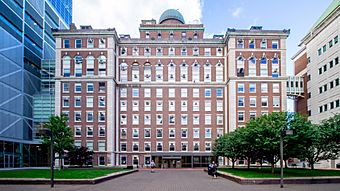Pupin Hall facts for kids
|
Pupin Physics Laboratory,
Columbia University |
|

Pupin Hall
|
|
| Location | New York, NY |
|---|---|
| Built | 1925 - 1927 |
| Architect | McKim, Mead, and White |
| Architectural style | Renaissance inspired with colonial influence |
| NRHP reference No. | 66000550 |
Quick facts for kids Significant dates |
|
| Added to NRHP | October 15, 1966 |
| Designated NHL | December 21, 1965 |
Pupin Physics Laboratories, also known as Pupin Hall, is a famous building at Columbia University in New York City. It's where students and scientists study physics and astronomy. You can find it on 120th Street, near Broadway.
This building is very important in science history. In 1965, it was named a National Historic Landmark. This was because of the amazing experiments done there, especially those related to splitting the atom. These experiments were key to the later Manhattan Project. In 2009, the American Physical Society also recognized Pupin Hall as a historic place. They honored scientist Isidor Isaac Rabi for his important work on magnetic resonance.
Contents
History of Pupin Hall
Pupin Hall was built between 1925 and 1927. It was needed to give the Physics Department more room. Before this, they were in a different building called Fayerweather Hall.
In 1935, the building was renamed after Mihajlo Idvorski Pupin. He was a Serbian-American scientist who graduated from Columbia. Later, he came back to the university's engineering school as a teacher. He helped start the electrical engineering department. Pupin was also a brilliant inventor. He created ways to take fast X-ray pictures. He also invented the "Pupin coil," which helped make long-distance telephone calls clearer. After he passed away in 1935, the university named the new physics building "Pupin Physics Laboratories" to remember him.
By 1931, Pupin Hall was a top research center. Harold Urey, who later won a Nobel Prize, discovered deuterium there. This is a special type of hydrogen. Another scientist, George B. Pegram, was studying the newly found neutron.
In 1938, Enrico Fermi came to Columbia University. He had just won the Nobel Prize for his work on radioactivity. He and his family moved from Italy to New York. Soon after, he started working at Pupin Hall. His research on nuclear fission, along with I. I. Rabi's work on atoms, began a golden age of science at the university.
One of the country's first cyclotrons was built in the basement of Pupin Hall. This machine helps scientists study tiny particles. It was built by John R. Dunning. The building became even more famous on January 25, 1939. On that day, Enrico Fermi successfully split a uranium atom in the United States for the very first time. This happened just 10 days after the world's first successful atom-splitting experiment in Copenhagen, Denmark.
Amazing Discoveries and Research
Pupin Hall is a landmark because of the big steps made in nuclear research there. This research was part of the Manhattan Project. This project was a secret effort to develop the first nuclear weapon.
Scientists at Pupin Hall made many other important discoveries. Here are some of them:
- The discovery of deuterium by Harold Urey.
- Studies of neutron behavior by George Pegram.
- Building one of the first cyclotrons in the country.
- The first splitting of a uranium atom in the U.S. by Enrico Fermi on January 25, 1939.
- Important measurements in 1947 by Willis Lamb and Polykarp Kusch. Their work helped create Quantum Electrodynamics and Quantum Field Theory. These are big ideas in physics about how light and matter interact.
- The discovery of parity violation by Chien-Shiung Wu. This showed that nature doesn't always treat left and right the same way. Tsung-Dao Lee and Yang Chen-Ning helped explain this idea.
- The idea for the laser was developed by Charles H. Townes and Arthur Leonard Schawlow. Lasers are used in everything from DVD players to surgery!
Building Features and Layout
The main entrance to Pupin Hall is actually on the 5th floor. You reach it from a plaza above the Dodge Physical Fitness Center. This means that many rooms on floors 2-4 are below the campus level. They don't have windows, even though they are above ground.
The original entrance was on the first floor. But it was blocked when the Dodge building was built in the 1960s. Sometimes, the entrance area smells like chlorine. This is because the Uris Pool has an exit stairway that leads into Pupin's entry.
The Rutherfurd Observatory is on top of Pupin Hall. The Astronomy Department often hosts "Public Observing Nights" there. People from around the area can come and look through a powerful optical telescope.
Famous Scientists and Students
Many brilliant scientists and students have worked at Pupin Hall. Here are some of them:
- I. I. Rabi
- Enrico Fermi
- R. A. Millikan
- Chien-Shiung Wu
- Julian Schwinger
- Polykarp Kusch
- Willis Lamb
- Tsung-Dao Lee
- Charles H. Townes
- Arthur Leonard Schawlow
- Horst Ludwig Störmer
- Tony Heinz
- Malvin Ruderman
- Norman Christ
- Alfred Mueller
- Allan Blaer
- Boris Altshuler
- Elena Aprile
- Rachel Rosen
- Brian Greene




